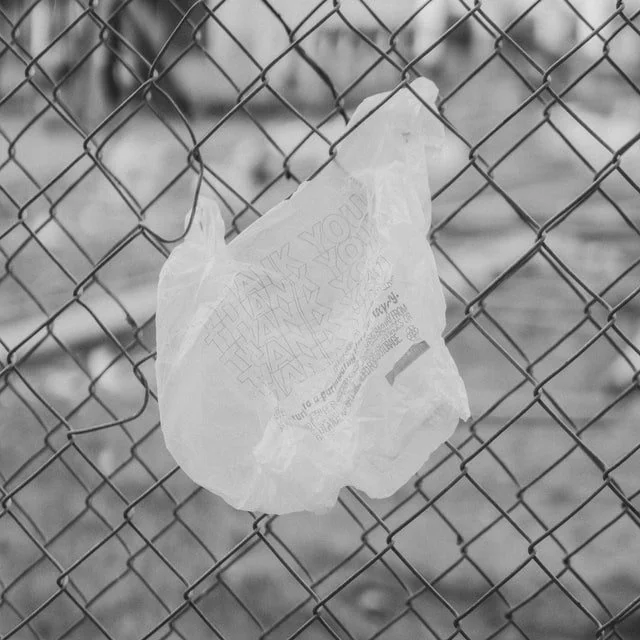
Explore ACAP Cape Breton’s research into plastic packaging alternatives through our report and videos.
In partnership with the Cape Breton Food Hub, ACAP Cape Breton has been exploring what sustainable packaging options exist for producers on Cape Breton Island.
Our Mission:
Support the elimination of single-use plastics.
The Challenge:
Avoid food waste.
We’ve taken a deep dive into packaging research, examining the challenges, opportunities and the future of sustainable packaging. We’ve also talked to experts in the field.
We investigated the following potential solutions to the single-use plastic problem.
Potential Solution 1:
Certified Compostable Bioplastic
What is bioplastic? Bioplastic is a plastic polymer made from renewable plant materials, such as starches or even food waste. It may be particularly useful for food packaging when contamination causes problems for recycling and composting is the better option (Sid et al., 2021)
Certified compostable materials are carefully lab-tested to ensure they will break down under certain conditions, and that the final composted product will not contain harmful microplastics. Microplastics are tiny plastic particles that can cause big problems for human and environmental health (Kitz et al., 2021; BPI, n.d.).
ACAP Cape Breton worked with waste facilities and producers in the Cape Breton Regional Municipality to identify a compostable bioplastic that could replace soft plastic produce bags. We decided to use Biobag produce bags, and distributed several hundred in the Fall of 2021. You may have received one with your Food Hub order.
We also did composting trials with three different composting methods.
The verdict:
We don’t recommend the BioBag for commercial use yet! Producers documented challenges with keeping some types of vegetables fresh- leafy greens in particular. The opaque green color caused concerns, as the produce inside wasn’t readily visible.
The good news is that this compostable bag actually broke down in our composting trials.
The bad news is that there are many compostable bioplastic products, from bags to clamshell containers, which are ONLY compostable in very specific conditions and cause problems for our municipal waste facilities. These products are labeled as a #7 plastic, which means that they are neither composted, nor recycled, but chucked in the landfill (Coppola et al., 2021; Sustainable Packaging Coalition, 2021; Bagheri et al., 2017).
For more information on some of these products, watch our short Plastics & Bioplastics explainer video above.
In 2019, the Ellen MacArthur Foundation (EMF) estimated that replacing 20% of single-use plastic represented a potential $10 billion USD industry.
Partnering with Urban Grow Farms, we examined a made-in-Cape Breton zero waste solution. Urban Grow Farms offers subscribers microgreens in a reusable container which is dropped off and collected by the business owners. Subscriptions are available for households, as well as businesses like restaurants and caterers.
We also asked participating customers for their feedback about the program, and the response was overwhelmingly positive:
“I like that the microgreens provide a fresh & local source of greens and nutrients during the winter months. I also am always looking for ways to reduce waste so that aspect of the program was really important to me!”
The verdict:
It’s challenging to implement a zero waste program that serves Cape Breton, or even the Cape Breton Regional Municipality. Urban Grow has sought innovative solutions like partnering with restaurants and creating efficient drop-off schedules.
More investment to scale up zero waste solutions is needed. Programs like this could help solve waste and contribute to local food security.
Both the federal and provincial governments are introducing new policy aimed at reducing single-use plastics in Canada.
The Canadian government has proposed a ban on six categories of single-use plastics: checkout bags, plastic cutlery, ring carriers, stir sticks, straws, and containers with “problematic” black plastic. This ban will take effect in 2023 and 2024. For more details, click here.
The Nova Scotia government is planning to implement Extended Producer Responsibility (EPR) legislation targeting single-use plastic, as well as paper. EPR makes the producer responsible for the costs of proper disposal of the item.
The verdict:
The Canadian government estimates that its legislation will decrease total plastic by 1.4 million tonnes over 10 years. However, this represents only 4% of the total plastic waste (Government of Canada, 2021). Let’s hope that this lays the groundwork for more ambitious legislation!
The Nova Scotia government is still developing its approach to EPR with few public details available yet. It will have to consider how to bring large producers on board with the stated goal of creating a more circular economy.
A deep dive into plastics:
-
The plastic that most of us purchase and then put out in our recycling bins or blue bags is made from fossil fuel sources. Biodegradable plastic is material that eventually breaks down in the environment and may include a combination of plant-based and fossil fuel sources. Compostable bioplastic is made from renewable, plant-based materials, which break down into compost materials.
-
Know the difference between biodegradable and compostable packaging. Although the two terms are used interchangeably, there is a stark difference in the context of these plastic packaging alternatives.
The term bioplastic can be deceiving. Although the term sounds like plastic which is made from natural materials, that is not the whole picture. Bioplastics come in many different chemical makeups, including some made with just plant materials and others made with a mixture of plant and fossil fuel plastic materials.
Understanding what materials are in the packaging products will greatly improve how you dispose of the item.
-
Bioplastics only account for about 2% of current plastics. This is due to a lack of waste facilities able to deal with bioplastics, increased costs of production AND composting, as well as available land to grow bioplastics. There are also ethical questions about whether bioplastics might exacerbate food insecurity through taking over agricultural land.
Researchers are investigating whether plant waste products like cucumber peels or grass-clippings could be used as bioplastic packaging materials, with promising results.
An additional concern with bio-based packaging is the shelf life of the packaging material and durability since the factors which impact food quality will also affect the plastic packaging alternative products (Sid et al., 2021). More research and trials are required to solve this problem!
-
Only 9% of plastics in Canada are recycled, and 4% are incinerated (with energy recovered). However, 86% of plastics go directly to the landfill, and the final 1% is plastic leakage into the environment (Deloitte & Cheminfo Services Inc., 2019).
Furthermore, food waste entering landfills contributes to methane emissions (Sustainable Packaging Coalition, 2021). As such, concerns associated with plastic packaging, greenhouse gas emissions from food waste entering landfills, plastic entering the environment via litter or other mismanagement practices harm the environment, specifically aquatic ecosystems (Kitz et al., 2021). A better solution is required to improve the well-being of both the environment and humans. Some associations have taken the initiative and are working towards a less-plastic future. In Canada, tomatoes sold in clamshell packaging and English cucumbers have reduced their plastic packaging by roughly 40% and 30%, respectively, using thinner film (Canadian Produce Marketing Association, 2019). However, more needs to be done. Promoting education around what local waste facilities can handle in terms of plastics, food waste, and plastic packaging alternatives can significantly improve efficiency and avoid unnecessary waste. Additional knowledge surrounding the availability and development of plastic packaging alternatives can encourage uptake.
References
Bagheri, A. R., Laforsch C., Greiner A., & Agarwal, S. (2017). Fate of so-called biodegradable polymers in seawater and freshwater. Global Challenges, 1(4), 1700048
BPI [Biodegradable Products Institute]. (n.d.). Value of certification. Accessed March 1, 2022.
Coppola, G., Gaudio, M. T., Lopresto, C. G., Calabro, V., Curcio, S., & Chakraborty, S. (2021). Bioplastic from renewable biomass: A facile solution for a greener Environment. Earth Systems and Environment, 5, 231–251.
EMF [Ellen MacArthur Foundation]. (n.d.). Plastics and the circular economy.
Government of Canada. (2021). Canada Gazette, Part I, Volume 155, Number 52: Single-Use Plastics Prohibition Regulations.
Kitz, R., Walker, T., Charlebois, S., & Music, J. (2021). Food packaging during the COVID-19 pandemic: Consumer perceptions. International Journal of Consumer Studies, 00, 1-15.
Sid, S., Mor, R. S., Kishore, A., & Singh Sharangat, V. (2021). Bio-sourced polymers as alternatives to conventional food packaging materials: A review. Trends in Food Science & Technology, 115, 87-104.
Sustainable Packaging Coalition. (2021). Understanding the role of compostable packaging in North America.





